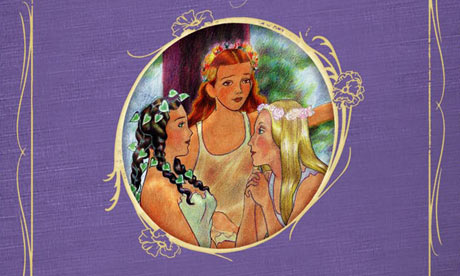Firstly, as a non-manga-reader undergoing continuing education in these blog series, I want to agree with Tom that the Okazaki’s artwork shocked and thrilled me at first glance. Her art looks more gestural than any other manga I’ve seen, and the thickish lines and largish facial features were much more relatable, for me, than the pin-thin perfect lines i’m used to seeing from our eastern brethren.
When manga characters elsewhere are composed so meticulously and in such delicate detail, it seems weird that their faces and bodies look all flat, whereas here, the flatness is right, cause they’re just shorthand sketches (I think it’s an important connection Tom makes to Andy Warhol: these characters strongly suggest 50s American gag and advertisement cartooning, which is a lot of why they felt so warmly familiar).
Of course, after the initial glow of recognition, Helter Skelter gave me the same problems I’ve had with most manga, namely the diffuculty of telling characters apart and the difficulty of distinguishing men from women. At first, I thought the makeup artist and the ingenue personal assistant turned sex slave turned hitwoman were different people, then I thought they were the same person, then at the end of the book I again thought that they were two people, and the makeup artist was in fact a man (reading Nana I learned to check for neck girth to determine a character’s sex, here that doesn’t work). But, I am still an outsider to the art form, and people have said my characters are hard to tell apart, so.
Like Noah and Tom, divasploitation doesn’t read as particularly feminist to me, or particularly new. Okazaki does a lot of telling-not-showing, in the form of the voiceovers, the quotations, and then the burning-tiger lsd scenes, that she’s getting at something bigger, deeper, more meta, but that part never really intrudes on the divasploitation enough to matter.
It’s funny, though, and probably telling of our different gender-coloured perspectives, that I had a different conviction from my co-utilitarians of where this awfully tired and predictable story was going.
Tom says, “Hana was there to be a doormat and let us see what a beast Ririko was. The cop was there to delve into the dark doings behind Ririko’s creation, to bring about justice at the end of the story, and in the meantime to give us some relief from Ririko’s twisted bitchiness and that of her milieu.” Cause I was sure that the cop was just an expositional device and a looming threat, whereas Helter Skelter would really be Hana’s story, the old “innocent, better-than-that girl is tempted by shallow beauty & riches, almost succumbs, but manages to triumphantly turn her back on it in the end” (hence my title). I really thought that’s where the Lancome-loaning scene, in particular, was going. (“No, Hana! She’ll get you hooked on the devil makeup!”)
But even though Ririko does talk about harming other people because she has been harmed, and refers to Hana in that context, she never actually harms Hana in the same way that she herself had been harmed. The makeup scene is actually just about Ririko’s bait-and-switch affections; Hana never gets designer clothes or a makeover, let alone surgery (Ririko encourages her sister to get surgery, but it reads as misguided empathy rather than cruelty). She uses Hana for nonconsensual but mutually enjoyable sex slavery, and for inappropriate errands up to and including grevious assault, but she never tries to remake Hana in her own image.
But that’s exactly what our conquering hero, the detective, does to Ririko. He renames her (it’s interesting how men in literature who set out to objectify, remake and possess a woman often start with assigning her a new name… was Lolita the first or just the most famous example?), stalks her all over and announces they were feathers together in a past life, before (as Noah so powerfully pointed out) tearing down her whole life, ruining her body’s chances of survival, and leaving her no recourse.
He’s as bad as “Mom,” maybe worse, because he’s an outsider who gets to lecture smugly as he objectifies, rather than being down in the beauty trenches (“Mom” reveals offhand that she’s surgically generated herself, so she is harming Ririko exactly as she was harmed). This is a feminist parable?? (This isn’t really undone by the darkly happy-ending epilogue, which goes against all the established rules about the sinister abortion surgery.)
Sigh. I might as well conclude with some more clueless-outsider bitching about manga. Okazaki pays lip service to it’s-bad-to-starve-yourself-to-get-supermodel-thin, but then every default female character has the same figure as Ririko, minus the breast implants and a couple of inches of height. Why aren’t we concerned about how all of them, by extension, are starving themselves? All the highschool girls we occasionally cut to, absorbing bad values from their fashion magazines, already look like fashion models (the only women with any fat on them, are the women whose fat is integral to the plot). That’s what happens when you draw a whole world in fashion illustration style, and that’s what all shonen and josei manga i’ve ever seen does.
Also, how every woman shown having sex has to explain at least once that she’s Not Really Into This Sort of Thing. Maybe it’s the innocent 50s romance referred to in comments, back before they discovered the female sex drive, or maybe it’s just another culture’s gender norms, which who-am-i-to-say are more fucked up than ours, but the good girl who has to be coerced is so not a turn-on for me. (That was one of my favourite things about Nana, even though it has the fashion-illustration crap in spades: it seemed to not share the above sexual hang-up at all. The good-girl-naif is actually shown to be pretty promiscuous in high school, and it’s just not a thing.)

